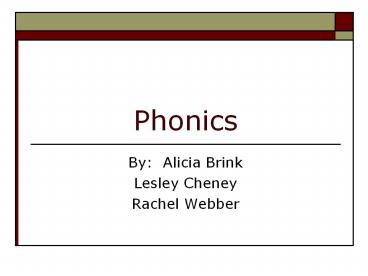Phonics - PowerPoint PPT Presentation
1 / 8
Title: Phonics
1
Phonics
- By Alicia Brink
- Lesley Cheney
- Rachel Webber
2
Phonics
- Phonics falls under the subject area of language
arts specifically reading. - It is typically used from pre-kindergarten
through second grade.
3
Phonics Defined
- It teaches the relationship between letters and
sounds and how to use this to read and write
words. - It is a work attack skill.
- You sound out words.
- There are six different techniques analogy
based, analytic, embedded phonics through
spelling, onset-rime instruction, and synthetic
phonics.
4
How does phonics work in a classroom?
- Instruction needs to be clear and direct.
- Students need opportunities to practice in order
to understand letter sound relationships. - Phonics instruction works better if the lesson is
kept short and is simply not drill and practice. - Integrate phonics throughout the curriculum and
not just in reading.
5
How to implement phonics strategies
- Mercer and Mercer (2005) suggest some general
guidelines for teachers in order to effectively
implement phonics. - These guidelines include
- using lowercase letters for beginning instruction
- introduce easy sounds and letters first
- introduce new letter-sound associations at a
reasonable pace - introduce vowels early but teach consonants first
- emphasize the common sounds of letters first
- teach sound blending early
- introduce regular words prior to irregular ones
6
Implications
- Phonics versus whole language controversy
- Phonics is based on taking parts to whole and the
whole language technique is holistic. - The choice of which strategy to use is based on
teacher opinion of what works and the school
curriculum. - Some critics also believe that there are too many
irregular words in the English language for
phonics to work. - Others believe that phonics provide a strong
background and key strategies to help students
figure out irregular words.
7
References
- Cunningham, P. (2005). Phonics they use Words
for reading and writing. Boston, MA Pearson. - Eldredge, J.L, Baird, J.E. (1996). Phonemic
awareness training works better than whole
language instruction for teaching first graders
how to write. Reading Research and Instruction,
35. Retrieved January 15, 2008, from
WilsonSelectPlus database. - Mercer, C. D., Mercer, A. R. (2005). Teaching
students with learning problems. Columbus, OH
Pearson. - Pikulski, D. J. (n.d.). The role of phonics in
the teaching of readng A Houghton Mifflin
position paper. Retrieved January 15, 2008, from
www.eduplace.com - Wagner, E. (n.d.). Word knowledge. Literacy at
school and home. Retrieved January 15, 2008,
from http//www.mason.gmu.edu
8
Additional Links
- Cliffords Sound Match Great interactive game
for young children - http//teacher.scholastic.com/clifford1/flash/phon
ics - Reading A to Z-Phonics
- http//www.readinga-z.com/phonics/reading-phonics.
php - Practice Quiz on Phonics
- http//english.glendale.cc.ca.us/phonics.html































